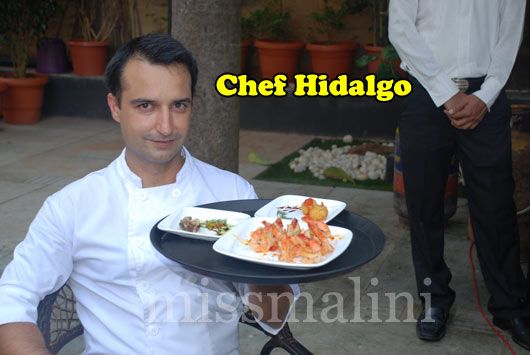
The class was beautifully constructed in Amadeus’s side porch with 2 massive paella pan’s set up. As Chef Guillermo had interestingly noted, the name for the traditional Spanish rice dish Paella actually comes from the word for the pan in which it is cooked. Thus the pan and the rice dish are both called Paella.
This was just one of the many interesting facts the Chef shared with us. He is an excellent demonstrator and taught the recipes for both a veg and non-veg Paella, step by step. Making it easy for a novice and expert cook alike. The smells coming from those pots were absolutely mouthwatering.
I especially enjoyed that he appealed to the Indian crowd by not only using a few Hindi words in his explanation, but also by explaining locally found ingredients that can be substituted to attain the same flavor.
For those of you planning to try out the recipe, you can find it below. The substitutions include using Arborio rice (can be found at natures basket, foodhall, etc.) for the dish instead of the traditional Bombarice that Chef Guillermo had used.
You need a thick, starchy rice to properly absorb the flavors and still have a nice bite. Using a Basmati type rice will become overcooked and soggy. He stuck to the traditional seasonings of paprika and saffron for his recipes, but suggested also using a little chili powder to cater to the Indian palate.
He offered some suggestions of leaving out the chorizo (for non-veg recipe) and using less oil, if you are being health conscience. There are a couple of general tips to keep in mind when cooking a Paella: One is to make sure not to stir the pot once the broth has been added.
This will break apart the rice, release more starch and change the consistency of the dish. Second, the rice should be submerged in the broth as it is cooking. If the rice is not evenly covered, add more broth. Finally, it is important to stick to the suggested cooking time.
Overall, the end results were delicious. For the non-veg Paella, Chef Guillermo used chicken, shrimp and chorizo in this recipe but stated that it can also be made as a seafood Paella, depending on your mood and local ingredients.
The chorizo in the non-veg recipe provided a lot of deep flavor, which is hard to imitate in the veg recipe.
Thus, I personally would recommend to make sure you use a very well flavored vegetable broth (I like the Knorr Bouillion cubes for a quick broth), add more crushed tomato for a more hearty deep flavor, include some more fresh herbs (parsley) and finally use more diverse veggies (carrots, snap peas, zucchini, whatever’s in season) to create more texture, color and add in some extra nutrients.
I also recommend not to over season during the cooking process, you can always add more salt at the end if needed.
The provided recipes were to serve as a guideline, leaving plenty of room to experiment with ingredients of your choice. I can’t wait to make my own variation tonight, Buen Provecho! J And muchas gracias Amadeus and Chef Guillermo!
Review by Heena Jain. Follow@ktchenbutterfly on Twitter
Video and Pictures: Ridhima Sinha

